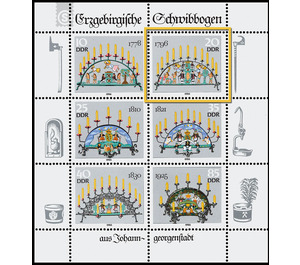Erzgebirge Schwibbogen - Germany / German Democratic Republic 1986 - 20 Pfennig
Theme: Devices, Items & Instruments
| Country | Germany / German Democratic Republic |
| Issue Date | 1986 |
| Face Value | 20.00 |
| Color | multi-colored |
| Perforation | K 14 |
| Printing Type | offset |
| Stamp Type | Postage stamp |
| Item Type | Stamp |
| Chronological Issue Number | 2800 |
| Chronological Chapter | GER-DDR |
| SID | 122667 |
| In 15 Wishlists | |
Erzgebirgische Schwibbogen from Johanngeorgenstadt The Ministry of Posts and Telecommunications of the German Democratic Republic issues six multicolored special postage stamps with illustrations of Erzgebirge Schwibbogen. The special postage stamps are printed on a miniature sheet with border design. No special first day cover envelope Special cancellation from 18 November 1986 to 17 January 1987 Schwibbogen called the Johanngeorgenstädter miners their Christmas chandeliers when they celebrated in their chewing on Stollenmundloch in contemplative round the last layer of the year. These arched candlesticks were a gift from the forge, the name comes from the hover arch of architecture. The distribution area of the Schwibbogen was limited, until fifty years ago exclusively on the Erzgebirgsort Johanngeorgenstadt. 20 pfennig value: Schwibbogen 1796 "Vivat Neulipziger Glück in J.G.Stadt" is written on the tape, with Neulipziger Glück meaning one of the then most famous Johanngeorgenstadt silver mines. This candle arch is 102 cm long and 49 cm high. Bow and sill are not riveted together as in the predecessors, but already screwed. In the picture dominate two mining motif groups in the center, the upper one was probably later inserted into the already existing composition. Held by two miners at the top is the Electoral Saxon coat of arms and below a dedication shield with a notable performance of important officers (mining officials) and the year 1796th The vignettes of the fringe design represent pieces of the mountain parades and miner's display. The beard (top left) of worn on the hay on the shoulder; among officiers she moved, often richly decorated, to the main showpiece. The approximately 65 cm long spar carries a metal, beilförmiges sheet, usually with a cloverleaf cutout. Forge masters and other groups of officers wore the Steigerhöckchen (top right) stock-like in the hand. The Froschlampe (middle right) is one of the oldest mining licorice species. From a shallow dish filled with tallow or rapeseed oil, the wick sticks out on a wick holder. In the case of the Freiberger Aperture, the bulb lamp filled with rapeseed oil is protected by a wooden housing lined with bare metal (center left). At the bottom left is the hat of a forge master. Colorful feather bushes on the hats were customary only at higher officer ranks and mountain musicians (bottom right). Preservation of old miner culture and preservation of mining traditions are part of the care of our society.


